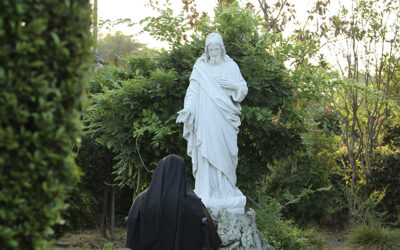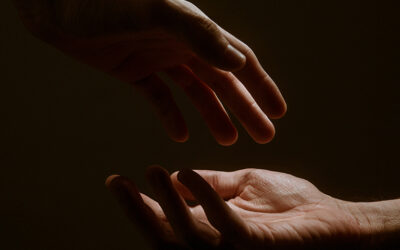By Father James Geoghegan, O.C.D.
Thérèse is the great saint of the virtue hope in modern times. She was sent to teach the Church and the world this confidence or trust in God. It was a gift she received in Baptism as a baby, and it grew and developed to the end of her life. Shortly before she died, Thérèse was asked if she completely trusted in God. Her answer amazes us for she says she does, but it was not always so. What held her back was her final illness, not because of the suffering it caused her, but because of the expense and suffering it imposed on her community. Then she realized that her illness was a gift from God to her Carmelite Sisters, and so she was able to abandon herself completely into the loving arms of Divine Providence.
There are some lovely events in her life that reveal her trust in God’s mercy. On May 28, 1897, Thérèse was ill, feverish and very tired, but not yet confined to bed. Sister John the Baptist approached and asked her to put the finishing touches to a painting. The daughter of a jeweler and lace maker, Thérèse was expert in doing delicate work with the paintbrush. Mother Agnes (Pauline) tried to dissuade the nun from bothering Thérèse, but the nun insisted. In her weariness, Thérèse got annoyed and showed it. Mother Agnes, who by this time was aware of the holiness and wisdom of Thérèse, was writing down all the sayings of her young sister. She was shocked to see Thérèse’s impatience. That night, Thérèse wrote Mother Agnes a letter that is a classic of Christian spirituality (Letter 230).
Thérèse told Mother Agnes that she is glad Mother saw her impatience and weakness. Now she will understand what Thérèse has been saying all along – that she is a weak, human person to whom God has been infinitely merciful. Thérèse saw Mother Agnes as a mirror of God’s mercy and compassion and so expected understanding and forgiveness.
Thérèse saw Sister John the Baptist as a mirror of God’s severity and justice. When Sister John the Baptist came by Thérèse later that day, Thérèse expected a scolding but was delightfully surprised. Sister John the Baptist embraced her, saying, “I felt sorry for you. I do not want to tire you out. I was wrong.” Thérèse returned to her cell and reflected on what had happened. Thérèse saw that God’s mercy and His justice are one. Because God is just, He takes our weaknesses into account and is merciful. Her trust in God’s mercy is based on His justice. No longer does she fear His justice for He is merciful.
Thérèse realized that her infinite desires to love and trust God are genuine and based on God’s love and His promises. Her trust is based not only on her faith and on the big promises of God to his people, but on her experience of His mercy in the little moments of her life. God’s loving mercy embraces the whole span of Thérèse’s life and every moment of it.
There is another incident in the life of our saint that again reveals her trust in God (Photo Album of St. Thérèse, photos 41, 42, 43). On June 7, 1897, the nuns knew of Thérèse’s illness and that they would soon lose her. It was a month before she moved to the infirmary. Desirous of getting a good, definitive photograph of her, Sister Genevieve (Celine) brought Thérèse out to the sacristy courtyard to take her photo. Thérèse was in her habit and mantle. She held a picture of the Holy Face of Jesus and another one of the Christ Child. These were iconic symbols of her name and her spirituality.
Celine had Thérèse kneel down on the ground. Then, like any photographer, she directed her model on how she should look and hold herself. Thérèse did not like to be photographed, but even though she had a fever, she went through it for the sake of her community. She posed for two photos, holding her pose for the long exposures. Celine used a large format view camera that took two exposures with one magazine.
Letting Thérèse free, Celine went into the darkroom to develop the negatives. She was disappointed with the results. In the first photo, Thérèse looked sad. In the second photo, she had moved, which caused a blur. Celine wanted a second session. Poor Thérèse dressed up again and knelt down. A gardener heard her say, “Hurry up, I’m exhausted.” Celine once more directed Thérèse. Both got angry.
These strong women clashed and tried to control each other. It is interesting that Celine took only one photo this session instead of the usual two which used both sides of the magazine. She left somewhat angry. This photo was successful, and in it you can see Thérèse’s utter exhaustion and fatigue.
A short time later, Mother Agnes passed by and found Thérèse weeping. Was it because Celine had hurt her or because she had hurt Celine? Thérèse just pointed to a hen with its chickens. She said that she was weeping with gratitude and joy because of the way the chicks were sheltered under the mother’s wings. That was how God had sheltered her all her life. She left her experience of weakness in the hands of God and moved on with her life.
Thérèse wrote in her autobiography around this time, “I must bear with myself, such as I am with all my imperfections.” On the other hand, Celine seems to have been distressed all that day because of the way she had treated her little sister who was dying. That evening, Celine received a letter from Thérèse (Letter 243) in which Thérèse suggested that the cause of Celine’s distress is disappointment in her own lack of virtue. Her impatience was revealed, and she was disappointed with herself. Thérèse encouraged her to accept her weakness and rejoice in her failings. Through them, she will know the power and the goodness and mercy of God.
We have seen through two incidents in our saint’s life that her trust in God reaches to small, passing events. Nothing, big or small, will hinder her trust in God and in His loving mercy. She tells us that it is the blind hope that she has in His Mercy that gives her strength and courage and is what pleases God (Letter 197 to Sister Marie of the Sacred Heart, her own sister, Marie).
The last words of Thérèse’s autobiography tell us that it is not because God has saved her from serious sin that she goes to Him with confidence and love; it is because God is merciful love and loves us in our weakness.




